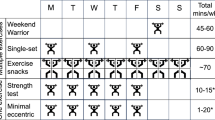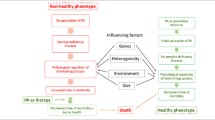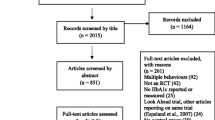Abstract
This study investigated whether imaging a brisk walk once a day over a week could increase barrier self-efficacy among women who wanted to increase their exercise behavior. Participants (N = 32, mean age = 31.90 years, SD = 10.17) were randomly allocated to either an imagery rehearsal group or control group. The 4 min 10 s guided imagery script was designed to tap several sources of self-efficacy (e.g., performance accomplishments). The participants completed the Barriers Self-Efficacy Scale (BARSE; McAuley 1992) before and after the intervention. Scores increased significantly for the rehearsal group but not for the control group but these changes were no longer significant after controlling for pre-exercise levels. Results show preliminary evidence that imagery can be used by women to increase their barrier self-efficacy, which in turn may increase the likelihood of successful exercise adherence.


Similar content being viewed by others
Notes
Coping self-efficacy, and its subtype of scheduling self-efficacy, is conceptually similar to barrier self-efficacy (Rodgers and Sullivan 2001; Ross-Stewart, Short, and Terrance, 2010), and the two terms have been used interchangeably. To avoid confusion, the present study adopts the term barrier self-efficacy.
The participants’ ease of imaging was assessed using the 7-point rating scale added to the EIQ (1 = very hard to image; 7 = very easy to image) and the mean of their imagery ability was 3.31 (SD = 1.32).
References
Andersson, E. K., & Moss, T. P. (2011). Imagery and implementation intention: A randomised controlled trial of interventions to increase exercise behaviour in the general population. Psychology of Sport and Exercise, 12, 63–70. doi:10.1016/j.psychsport.2010.07.004.
Anton, S. D., Duncan, G. E., Limacher, M. C., Martin, A. D., & Perri, M. G. (2011). How much walking is needed to improve cardiorespiratory fitness? An examination of the 2008 Physical Activity Guidelines for Americans. Research Quarterly for Exercise and Sport, 82(2), 365–370. doi:10.1080/02701367.2011.10599766.
Ashford, S., Edmunds, J., & French, D. P. (2010). What is the best way to change self-efficacy to promote lifestyle and recreational physical activity? A systematic review with meta-analysis. British Journal of Health Psychology, 15, 256–288. doi:10.1348/135910709X461752.
Bandura, A. (1986). Social foundations of thought and action. Englewood Cliffs: Prentice-Hall.
Bandura, A. (1997). Self-efficacy: The exercise of control. New York: W. H. Freeman.
Blair, S. N. (2009). Physical inactivity: the biggest public health problem of the 21st century. British Journal of Sports Medicine, 43, 1–2.
Callow, N., Hardy, L., & Hall, C. (2001). The effect of a motivational-mastery imagery intervention on sport confidence of three elite badminton players. Research Quarterly for Exercise and Sport, 72, 389–400.
Chan, C. K. Y., & Cameron, L. D. (2012). Promoting physical activity with goal-oriented mental imagery: A randomized controlled trial. Journal of Behavioral Medicine, 35, 347–363. doi:10.1007/s10865-011-9360-6.
Cumming, J. (2008). Investigating the relationship between exercise imagery, leisure-time exercise behavior, and self-efficacy. Journal of Applied Sport Psychology, 20, 184–198. doi:10.1080/10413200701810570.
Cumming, J., Olphin, T., & Law, M. (2007). Self-reported psychological states and physiological responses to different types of motivational general imagery. Journal of Sport and Exercise Psychology, 29, 629–644.
Duncan, L. R., Rodgers, W. M., Hall, C. R., & Wilson, P. M. (2011). Applied Psychology: Health and Well-being, 3, 107–126. doi:10.1111/j.1758-0854.2010.01043.x.
Gammage, K. L., Hall, C. R., & Rodgers, W. M. (2000). More about exercise imagery. The Sport Psychologist, 14, 348–359.
Giacobbi, P. R., Jr., Hausenblas, H. A., & Penfield, R. (2005). Further developments in the measurement of exercise imagery: The exercise imagery inventory. Measurement in Physical Education and the Exercise Sciences, 9, 251–266. doi:10.1080/10413200701601508.
Godin, G., & Shephard, R. J. (1985). Psycho-social predictors of exercise intentions among spouses. Canadian Journal of Applied Sport Science, 10, 36–43.
Hall, C. R., Rodgers, W. M., Wilson, P. M., & Norman, P. (2010). Journal of Applied Social Psychology, 40, 135–152. doi:10.1111/j.1559-1816.2009.00566.x.
Hausenblas, H. A., Hall, C. R., Rodgers, W. M., & Munroe, K. J. (1999). Exercise imagery: Its nature and measurement. Journal of Applied Sport Psychology, 11, 171–180. doi:10.1080/10413209908404198.
Health and Social Care Information Centre. (2013). Health survey for England 2012: Physical activity and fitness. Leeds: Health and Social Care Information Centre.
Jacobs, D. R., Ainsworth, B. E., Hartman, T. J., & Leon, A. S. (1993). A simultaneous evaluation of ten commonly used physical activity questionnaires. Medicine and Science in Sports and Exercise, 25, 81–91.
Lang, P. J. (1979). A bio-informational theory of emotional imagery. Psychophysiology, 16, 495–512.
Lang, P. J., Kozak, M. J., Miller, G. A., Levin, D. N., & McLean, A., Jr. (1980). Emotional imagery: Conceptual structure and pattern of somato-visceral response. Psychophysiology, 17, 179–192.
Lee, L. L., Avis, M., & Arthur, A. (2007a). Evaluating a community-based walking intervention for hypertensive older people in Taiwan: A randomized controlled trial. Preventive Medicine, 44, 160–166. doi:10.1016/j.ypmed.2006.09.001.
Lee, L. L., Avis, M., & Arthur, A. (2007b). The role of self-efficacy in older people’s decisions to initiate and maintain regular walking as exercise—findings from a qualitative study. Preventive Medicine, 45, 62–65. doi:10.1016/j.ypmed.2007.04.011.
Lee, L., Arthur, A., & Avis, M. (2008). Using self-efficacy theory to develop interventions that help older people overcome psychological barriers to physical activity: A discussion paper. International Journal of Nusing Studies, 45, 1690–1699. doi:10.1016/j.ijnurstu.2008.02.012.
Lovell, G., El Ansari, W., & Parker, J. (2010). Perceived exercise benefits and barriers of non-exercising female university students in the United Kingdom. International Journal of Environmental Research and Public Health, 7, 784–798. doi:10.3390/ijerph7030784.
McAuley, E. (1992). The role of efficacy cognitions in the prediction of exercise behavior in middle-aged adults. Journal of Behavioral Medicine, 15, 65–88.
McAuley, E., & Blissmer, B. (2000). Self-efficacy determinants and consequences of physical activity. Exercise and Sport Sciences Reviews, 28, 85–88.
McAuley, E., Poag, K., Gleason, A., & Wraith, S. (1990). Attrition from exercise programs: Attributional and affective perspectives. Journal of Social Behavior and Personality, 5, 591–602.
McAuley, E., Jerome, G. J., Marquez, D. X., Elavsky, S., & Blissmer, B. (2003). Exercise self-efficacy in older adults: Social, affective, and behavioral influences. Annals of Behavioral Medicine, 25, 1–7. doi:10.1207/S15324796ABM2501_01.
McKenzie, A. D., & Howe, B. L. (1997). The effect of imagery on self-efficacy for a motor skill. International Journal of Sport Psychology, 28, 196–210.
Menzies, V., Taylor, A. G., & Bourguignon, C. (2006). Effects of guided imagery on outcomes of pain, functional status and self-efficacy in persons diagnosed with fibromyalgia. Journal of Alternative and Complementary Medicine, 12, 23–30. doi:10.1089/acm.2006.12.23 DOI:10.1089/acm.2006.12.23#_blank.
Morseth, B., Emaus, N., Wilsgaard, T., Jacobsen, B. K., & Jørgensen, L. (2010). Leisure time physical activity in adulthood is positively associated with bone mineral density 22 years later. The Tromsø study. European Journal of Epidemiology, 25, 325–331. doi:10.1007/s10654-010-9450-8.
Nies, M. A., & Sun, Y. (2008). Responders and nonresponders to a walking intervention for sedentary women. Journal of Nursing Scholarship, 40, 226–234. doi:10.1111/j.1547-5069.2008.00230.x.
Proper, K. I., Singh, A. S., van Mechelen, W., & Chinapaw, M. J. M. (2011). Sedentary behaviors and health outcomes among adults: A systematic review of prospective studies. American Journal of Preventive Medicine, 40, 174–182. doi:10.1016/j.amepre.2010.10.015.
Robin, N., Dominique, L., Toussaint, L., Blandin, Y., Guillot, A., & Le Her, M. (2007). Effect of motor imagery training on service return accuracy in tennis: The role of imagery ability. International Journal of Sport and Exercise Psychology, 5, 175–186. doi:10.1080/1612197X.2007.9671818.
Rodgers, W. M., & Sullivan, M. J. L. (2001). Task, coping and scheduling self-efficacy in relation to frequency of physical activity. Journal of Applied Social Psychology, 31, 741–753. doi:10.1111/j.1559-1816.2001.tb01411.x.
Ross-Stewart, L., Short, S. E., & Terrance, C. A. (2010). A narrative review of the relationships among imagery, exercise, and self-efficacy. Journal of Imagery Research in Sport and Physical Activity, 5(1). doi:10.2202/1932-0191.1051
Short, S. E., Hall, C. R., Engel, S. R., & Nigg, C. R. (2004). Exercise imagery and the stages of change. Journal of Mental Imagery, 28, 61–78.
Stanley, D. M., & Cumming, J. (2010a). Not just how one feels, but what one images? The effects of imagery use on affective responses to moderate exercise. International Journal of Sport and Exercise Psychology, 8, 343–359. doi:10.1080/1612197X.2010.9671957.
Stanley, D. M., & Cumming, J. (2010b). Are we having fun yet? Testing the effects ofimagery use on the affective and enjoyment responses to acute moderate exercise. Psychology of Sport and Exercise, 11, 582–590.
Talbot, L. A., Metter, E. J., & Fleg, J. L. (2000). Leisure time physical activities and their relationship to cardiorespiratory fitness in healthy men and women 18–95 years old. Medicine and Science in Sports and Exercise, 32, 417–425. doi:10.1097/00005768-200002000-00024.
Thorp, A. A., Owen, N., Neuhaus, M., & Dunstan, D. W. (2011). Sedentary behaviors andsubsequent health outcomes in adults a systematic review of longitudinal studies,1996–2011. American Journal of Preventive Medicine, 41, 207–215. doi:10.1016/j.amepre.2011.05.004.
Warburton, D. E., Nicol, C., & Bredin, S. S. (2006). Prescribing exercise as preventive therapy. Canadian Medical Association Journal, 7, 961–974. doi:10.1503/cmaj.1040750.
Wesch, N. N., Milne, M. I., Burke, S. M., & Hall, C. R. (2006). Self-efficacy and imagery use in older adult exercisers. European Journal of Sport Science, 6, 197–203.
Williams, S. E., Cumming, J., & Balanos, G. M. (2010). The use of imagery to manipulate challenge and threat appraisal states in athletes. Journal of Sport and Exercise Psychology, 32, 339–358.
Williams, S. E., Cooley, S. J., & Cumming, J. (2013). Enhancing an individual’s imagery ability: Can layering images facilitate ease of imaging? Journal of Sport and Exercise Psychology, 35, 60–71.
Wise, J. B., & Trunnell, E. P. (2001). The influence of sources of self-efficacy upon Efficacy strength. Journal of Sport and Exercise Psychology, 23, 268–280.
Withall, J., Jago, R., & Fox, K. R. (2011). Why some do but most don’t. Barriers and enablers to engaging low-income groups in physical activity programmes: A mixed methods study. BMC Public Health, 11, 207–219. doi:10.1186/1471-2458-11-507.
World Health Organization (2010). Global recommendations on physical activity for Health. Geneva: World Health Organization. Retrieved from http://whqlibdoc.who.int/publications/2010/9789241599979_eng.pdf.
Author information
Authors and Affiliations
Corresponding author
Additional information
All authors, School of Sport and Exercise Sciences, University of Birmingham at Birmingham, UK.
The authors would like to thank Jonathan Whittall, Frances Reed, and Deborah Flitney for their help with participant recruitment and data collection.
Rights and permissions
About this article
Cite this article
Weibull, F., Cumming, J., Cooley, S.J. et al. Walk this Way: A Brief Exercise Imagery Intervention Increases Barrier Self-Efficacy in Women. Curr Psychol 34, 477–490 (2015). https://doi.org/10.1007/s12144-014-9271-0
Published:
Issue Date:
DOI: https://doi.org/10.1007/s12144-014-9271-0




